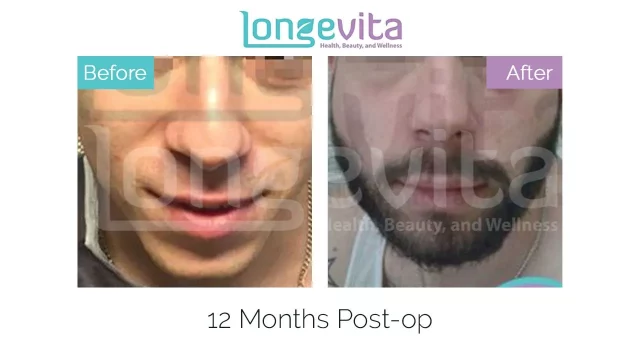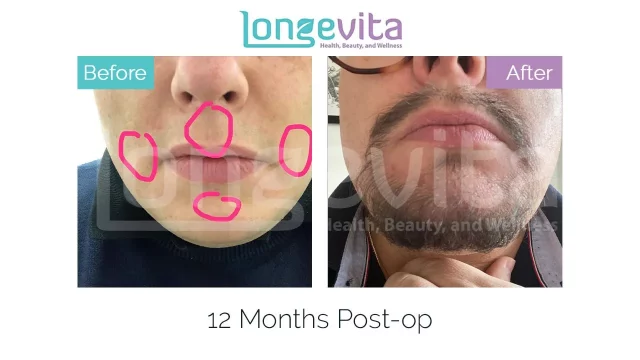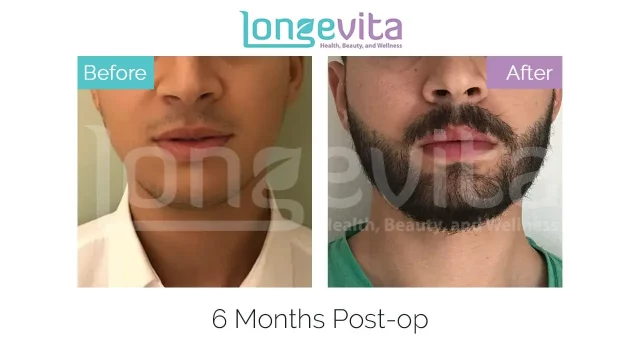What is a Moustache Hair Transplant?
For this facial hair transplant in Turkey, commonly, the FUE hair transplant method is used, with the scalp as the donor site. But the FUT hair transplant method can also be considered.
This surgery specifically targets the upper lip area. The moustache design is drawn according to different face shape measurements and the aesthetic goals of the patient.
Through this, the surgeon will determine the number of grafts that need extraction from the back/sides of the head.
The surgeon takes the differences in the texture, thickness, and colour of facial and head hair into consideration to ensure natural results.
Many men struggle to grow a moustache because of genetics, hormones, physical trauma, or underlying medical conditions.
Those who have a thin, patchy moustache can restore hair growth through a moustache hair transplant.
How much does a Moustache Transplant Cost?
A moustache hair transplant in Turkey may cost around £1,300.
In general, healthcare in Turkey is more affordable because of the low cost of living (compared to other countries). It is also because of the currency exchange rate. And so because of the lower cost of medical equipment, operation theatres, and labour, the cost of a moustache transplant in Turkey is 3-5 times lower than in the UK or other European countries.
In Turkey, the cost of a moustache transplant does not vary according to the number of grafts a patient needs; instead, they get maximum grafts in one session, which further saves cost. In addition, they can choose a treatment plan that is inclusive of the cost of surgery, translators, hotel accommodation, transfer services, and aftercare.
Who Can Have Moustache Hair Transplant & Why
A patient is eligible for this surgery only if they have a donor area with a high hair density.
If you have sparse, patchy, uneven or complete lack of moustache hair due to the following reasons, you can get a restoration surgery:
- Genetics
- Alopecia areata
- Scars (surgery or physical trauma)
- Burn injury
- Chemotherapy-induced alopecia
What To Think About Before You Have A Moustache Hair Transplant
Before choosing the surgeon, ask them if they are specialists in this surgery.
Moreover, find out for how long they have been performing this surgery and the number of moustache hair transplants they have performed.
Every surgery carries a risk of complication, so ask them about the complications that can arise from this surgery and how they dealt with them in the past.
You can ask for the figures of success and patient satisfaction rates, but you can also request an in-person or virtual meeting with a previous patient of the surgeon who had a moustache transplant.
This will help you in making a more informed decision.

Preparing for Moustache Transplant Surgery
To prepare for your surgery, here are some common pre-operative do’s and don’ts:
Do...
- Inform us about your routine medications and any diseases. Don't forget to inform us of any changes to your health or medications
- Inform us at least 1 week prior to your arrival if you have any redness, rash, itchiness, pimples or dandruff on your head
- Stop taking Asprin, blood thinners, steroids or anti-inflammatory medications 1 week prior to your procedure
- Stop using Minoxidil or Finasteride for 1 week prior to surgery
- Wear a buttoned shirt or zipper top when coming to the clinic
- Remove any sprays, gels or cosmetics prior to coming to the clinic
- Take all your regular medications as normal, except for the ones we asked you to stop
- Stop taking blood thinners 2 weeks before the surgery
- If you are taking broad beta-blockers please contact your surgeon before your surgery
Don't...
- Don't smoke, drink alcohol or do any recreational drugs at least 1 week before the surgery.
- Don't take vitamin B and E for 1 week before your procedure
- Don't take any herbal products or vitamins for 1 week prior to surgery
- Don't cut your hair - leave it as long as possible as it makes planning for the procedure easier. If you are wearing a hair system, remove it 3 days prior to your procedure
- Don't wear a t-shirt or any clothing that must be pulled over your head
- Don't drive on the day of your treatment. You will be given a sedative and will not be fit to drive afterwards
- Don't take any supplements 1 week before your hair transplant
Please note: Cardiac patients may need written consent from their cardiologist.
What Is The Procedure For Moustache Hair Transplant?
First, the surgeon will shave the donor and recipient areas for better visibility.
Then, they will administer local anaesthesia on the scalp for the extraction of individual hair follicles using the punch tool.
After the excision, the hair grafts are placed in a solution to ensure their survival.
After local anaesthesia takes effect, the surgeon makes incisions in the upper lip area to insert the grafts.
Here, direct hair implantation can also take place. The surgical time is 2-3 hours. However, it can vary depending on the number of hair follicles the patient needs.

Recovery And Results
You may be discharged the same day. And you can even fly back home the next day after you’ve had your check-up appointment.
The surgeon may prescribe you medications for the recovery process since you may experience swelling, bleeding, numbness, pain, and bruising on the upper lip.
You may temporarily lose hair from the back of the head and the moustache following the transplant due to shock loss.
However, the hair will start growing back in 3 months. The scarring from incisions in the upper lip should fade in a year.
You’ll also have barely noticeable scars from the punch tool in the donor area.
The results from this hair transplant procedure will become visible in 3-6 months. However, full recovery can take a year.
Aftercare
After your moustache transplant, you should make sure to keep your head elevated.
Even when sleeping, angle your pillow at 45 degrees to reduce swelling. Moreover, make sure that you do not bend, and move around carefully so as to not hit your face.
Drink lots of water and avoid hard foods. If you open your mouth too wide or chew vigorously, you may stretch the skin and damage the grafts.
Also, if you consume salt, the swelling will last for a longer time.
In addition, avoid pressurized showers with water that is too hot or cold.
For at least a month, you cannot go to the gym, sauna, hot tub, or outside under direct sunlight.
Wash the donor and recipient areas with the given products according to the instructions of the surgeon.
Alternatives to Moustache Transplants
If you have a weak donor area, you may not be eligible for a moustache transplant. This is especially if you also want to undergo a scalp hair transplant.
In this case, you can consider taking medications for moustache hair, along with supplements, after discussing it with your doctor.
Other Procedures to Have with Moustache Transplants
If the facial hair in the beard region (chin and cheeks) is lacking, sparse, or patchy, you can also benefit from beard transplant service this surgery, and you may combine it with a sideburn restoration surgery.
Other than that, you can get PRP therapy to improve the results of the surgery while speeding up the recovery.
Frequently asked questions
You won’t feel any pain during the moustache transplant surgery. But when getting an injection for local anaesthesia, you may feel pain and discomfort since the skin is thinner in the upper lip area.
After the surgery, the surgeon will prescribe you painkillers for pain management once the effects of anaesthesia wear off.
You will receive the CVs and portfolios of the surgeons who perform this surgery. You can learn about the qualifications and experience of the surgeon you choose to go with from there.
Yes, the surgeon performing your moustache transplant will have insurance against malpractice.
Generally, it’s safe and low-risk surgery, but if you’re experiencing a problem, you can get in touch with our aftercare team. You can open a ticket online via the Support Portal, message, call or email us for help.
An infection in the upper lip can develop. It may be the result of touching or scratching the surgical area or exposure to dust and microbes. As the surgery requires making small incisions in the recipient area, the open wounds are vulnerable to infection, even as they’re healing. If you do not take your antibiotics as prescribed by the surgeon, the risk of infection increases.
You may temporarily experience:
- Swelling on the face due to local anaesthetics
- Scarring in the donor and recipient areas
- Numbness and itching in surgical areas
- Bleeding
- Leakage of the local anaesthesia drugs and other fluids injected during the surgery in the donor and recipient areas. It is normal and can last for 2-3 days.






